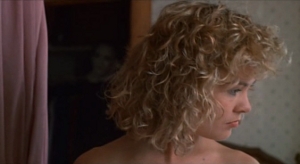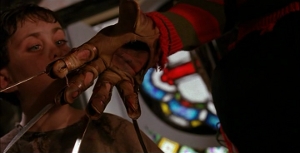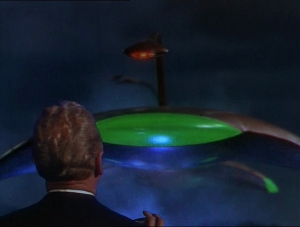Monthly Archives: August 2011
Trash Culture’s Doctor Who Reviews – An Unearthly Child (1963)
by Chad Denton
Synopsis
Ian Chesterton, a science teacher, and Barbara Wright, a history teacher, share their concerns about their eccentric 15-year old student, Susan. Barbara confides that when she went to meet Susan’s sole guardian, her grandfather, to talk about the sliding down of her homework grades, she could only find a scrapyard at the address on file. The two decide to literally stakeout the scrapyard in their car while waiting for Susan to walk back from school. While they wait, the two discuss how Susan is a brilliant student in science, math, and history, but doesn’t seem to grasp common knowledge facts like that Britain doesn’t have a decimal system for its currency and another time when she insisted that a simple math problem required five dimensions, not three. When Susan appears and walks into the scrapyard, Ian and Barbara follow, but only find an out-of-place police box and an old man. Instantly hostile and suspicious, the man denies that Susan came by and asks Ian, “Is it reasonable to suppose that anybody would be inside a cupboard like that?” After an argument Ian, thinking the old man kidnapped Susan, threatens to go to the police, but Susan comes out of the box looking for the man, whom she addresses as “Grandfather.” Continue reading Trash Culture’s Doctor Who Reviews – An Unearthly Child (1963)
Ghidorah, the Three-Headed Monster (1964)

How about I take cheap shots at a film I love for a change? I seem to be running on a solid three-to-one ratio. And Japan was still synonymous with “cheap” back when this film came out, despite it being the most lavish Godzilla movie ever made…a title it would hold for a full year.
As I’ve said, with Mothra vs. Godzilla the Ishiro Honda repertory company came into the full force of its power. Its international success, combined with that of its prequel, King Kong vs. Godzilla, ensured everyone, from series producer Tomoyuki Tanaka on down, access to more cash. This allowed the Godzilla series, for a few brief, shinning years, to top itself with each subsequent entry by doing something anathema to modern Hollywood. I think they used to call it “innovating.” Continue reading Ghidorah, the Three-Headed Monster (1964)
Halloween 5: The Revenge of Michael Myers (1989)

These Slasher sequels are supposed to be simple. Trot out a brace of clay pigeons, watch them all die one by one, tack on some stupid cliffhanger, and you’re all good to go. It seems impossible to screw that up, but by God, Mustapha Akkad found a way. Several, in fact.
The first, Halloween 4, was a complete waste of its own potential, meant to compete with the other Big Names in this sub-genre by copying all their worst eccentricities. By 1989, the Friday the 13th and Nightmare on Elm Street films had long-since surpassed the original Halloween in the popular imagination. They (rightly or not…mostly not) were synonymous with American horror movies of the late-80s, leaving their mutual progenitor in the box office dust.
Akkad couldn’t allow that. Nor could he allow Halloween 5 to pick up where the last left off. Sure, The Revenge begins with a re-staging of The Return‘s final moments, but that somehow makes it worse. Unlike the mouth-breathing audiences Akkad obviously targeted, I actually remember the end of Halloween 4. I hoped it signaled a spark of creativity finally flaring up within this franchise. Nice of Halloween 5 to crush that right out of the gate. Continue reading Halloween 5: The Revenge of Michael Myers (1989)
Trash Culture’s Ninja Turtles Rip-Offs, Case Study #1: Biker Mice From Mars
by Chad Denton
Does anything illustrate just how convoluted pop culture can be more than Teenage Mutant Ninja Turtles? What started out as a comic book parody of Frank Miller’s run on Daredevil turned into a children’s cartoon that itself inspired a legion of imitators and parodies. I even have a theory that the deluge of anthropomorphic animal warriors hitting ’90s televisions has led to one of the most notorious cultural phenomena of the twenty-first century so far, but we’ll get to that in the moment.
I have three case studies to go through, but let’s begin with one of the better examples.
 Continue reading Trash Culture’s Ninja Turtles Rip-Offs, Case Study #1: Biker Mice From Mars
Continue reading Trash Culture’s Ninja Turtles Rip-Offs, Case Study #1: Biker Mice From Mars
A Nightmare on Elm Street 5: The Dream Child (1989)

In spite of the 1988 Writer’s Strike, shoddy direction, and Fred Kreuger’s dual role as both an immortal dream monster and a lame stand-up comedian, Nightmare on Elm Street 4 managed to become the most successful film in the franchise…up to that time.
It’s easy to see why. The financial successes of Parts 2 and 3 led to the most interesting phenomenon in the Slasher movie’s short history. Hard as it is for genre fans to pronounce this word without retching, Slasher movies became…ugh…mainstream. It took ten years, but these Old Testament morality plays disguised as exploitative gore fests went from urban, independent theaters to multiplexes across the U.S. and around the world. Both Friday the 13th and Nightmare on Elm Street fielded successful TV series and horror merchandising started to ramp up to levels it hadn’t achieved since the ’50s.
Nowadays we can look back and see the sub-genre’s slow motion death, but 1989 was actually a rare year for the cosmopolitan horror fan who’d yet to turn their nose up at the Slasher movie. That was the year all three of the “name” Slasher franchises pushed out crap sequels. In fact, that summer saw a stupefying succession of sequels, with Indiana Jones and the Last Crusade leading the pack. Star Trek V, Ghostbusters II, Karate Kid Part III, they all followed in an attempt to derail a little Warner Brothers picture everyone had heard about that was supposed to be half-decent, called Batman.
How could Freddy hope to stand against all that? The short answer is: he didn’t. Continue reading A Nightmare on Elm Street 5: The Dream Child (1989)
A Nightmare on Elm Street 4: The Dream Master (1988)

By this point the Nightmare films were officially on auto-pilot, each one more profitable and less sensible than its predecessor. In terms of sheer dollars, the initial trilogy of Nightmares became a living refutation of the Law of Diminishing returns. The first grossed $25 million in theaters. Freddy’s Revenge pulled in over twice that. Dream Warriors broke them both, along with the bank, with an $87 million gross. Its success triggered the last great wave of Slasher movies. Most of them are rightly and truly forgotten, looked down upon even by sub-genre fans as the movies that finally ruined everything for everybody.
Except this one. While researching this review, I found an inordinate number of folks willing to give Nightmare on Elm Street 4 a pass. Not just for the usual, “It’s a Slasher movie, whaddaya expect?” bullshit reasons, but for their own reasons, varied as the person itself. Too bad I’ve always hated this movie. And now that I know why. I know this movie and I were destined to be enemies from the start. Say what you want about New Nightmare or Freddy’s Dead. For me, coming off the high-highs of Dream Warriors, this movie became the lowest of the series many lows. Continue reading A Nightmare on Elm Street 4: The Dream Master (1988)
The Top 5 Dumbest Things in Batman Forever
The War of the Worlds (1953)

I’m sorry. That title line should read,
“And now, fought with the terrible weapons of Super Science(!), menacing all mankind and every creature on Earth comes: THE WAR OF THE WORLDS!”
So our Humble Narrator concludes as the black-and-white pre-title montage of World War stock footage gives way to the bright, technicolor titles of this, the Alien Invasion movie that inspired all subsequent Alien Invasion movies. All of them – from the Independence Days of my childhood to the Battle: Los Angeles of today – owe their existence to this…which in turn owes its own existence to Orson Welles. Continue reading The War of the Worlds (1953)
The Quick and the Dead (1995)

A lot of people rightly praise Sam Raimi’s Evil Dead trilogy, but I’ve always preferred his…”more mature” feels like an obscenely inaccurate phrase, so I’ll just call them his “middle-period” pieces. Between Evil Dead 2 and Spider-Man, Raimi struggled for mainstream success, feeling – like every decent genre director in the ’80s and ’90s – that niche audiences and cult success are all well and good…until you looked at the numbers. Besides, Universal wanted to create its own TV channel. Who better to make that happen than a writer/director/producer triple threat?
These struggles cost him fans and failed to win him the wide audience Hollywood’s power brokers and spreadsheet psychics insist every director must possess before they’re allowed to sit in the Front Room with the Grown Ups, where they might accidentally/on-purpose break the studio’s Nice Things (like, oh, I don’t know, say…a profitable superhero franchise). While Darkman and Army of Darkness are “kinder” and “gentler” films than either previous Dead movie (and easier to follow than the Great Black Mark on Raimi’s pre-Spider-Man career, Crimewave), I’m going to own up another Fanboy Heresy and admit I actually prefer them to the original Dead duology.
Not that I don’t love the Dead movies, but I prefer flicks with characters over flicks with mobile viscera containers (that just so happen to speak and/or emote). Why do you think I go out of my way to avoid “art house” or “Sundance Channel” films? Continue reading The Quick and the Dead (1995)
